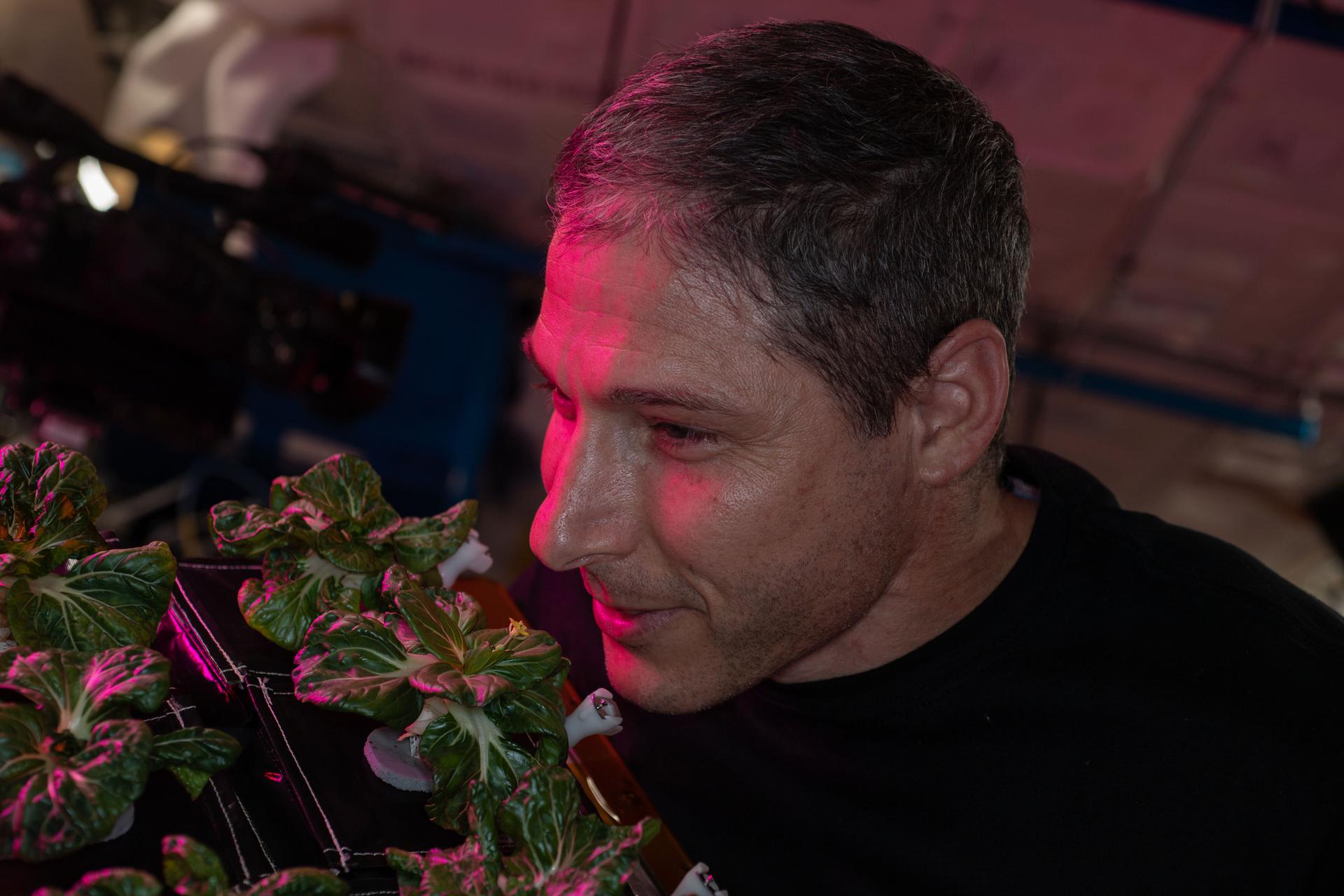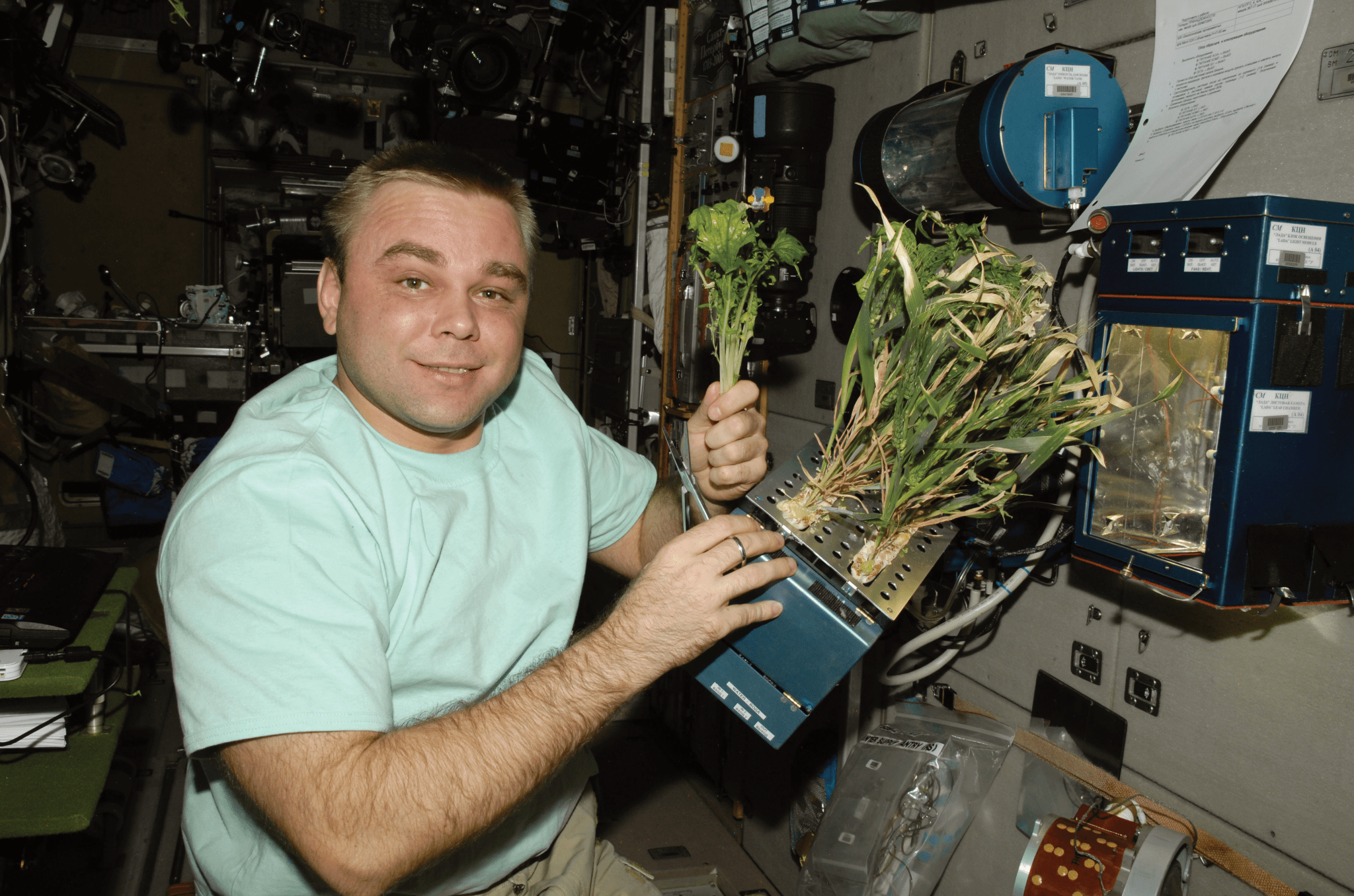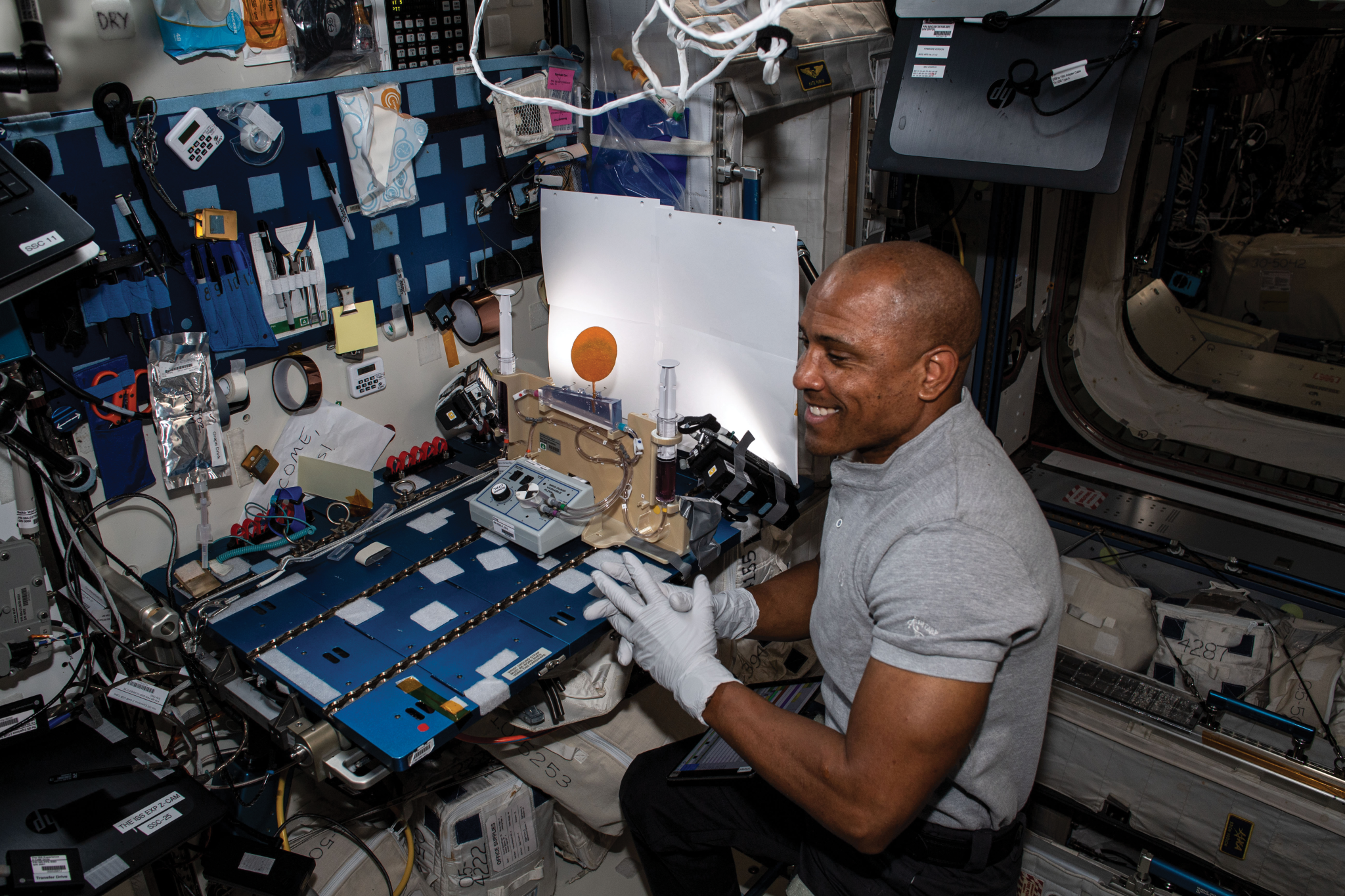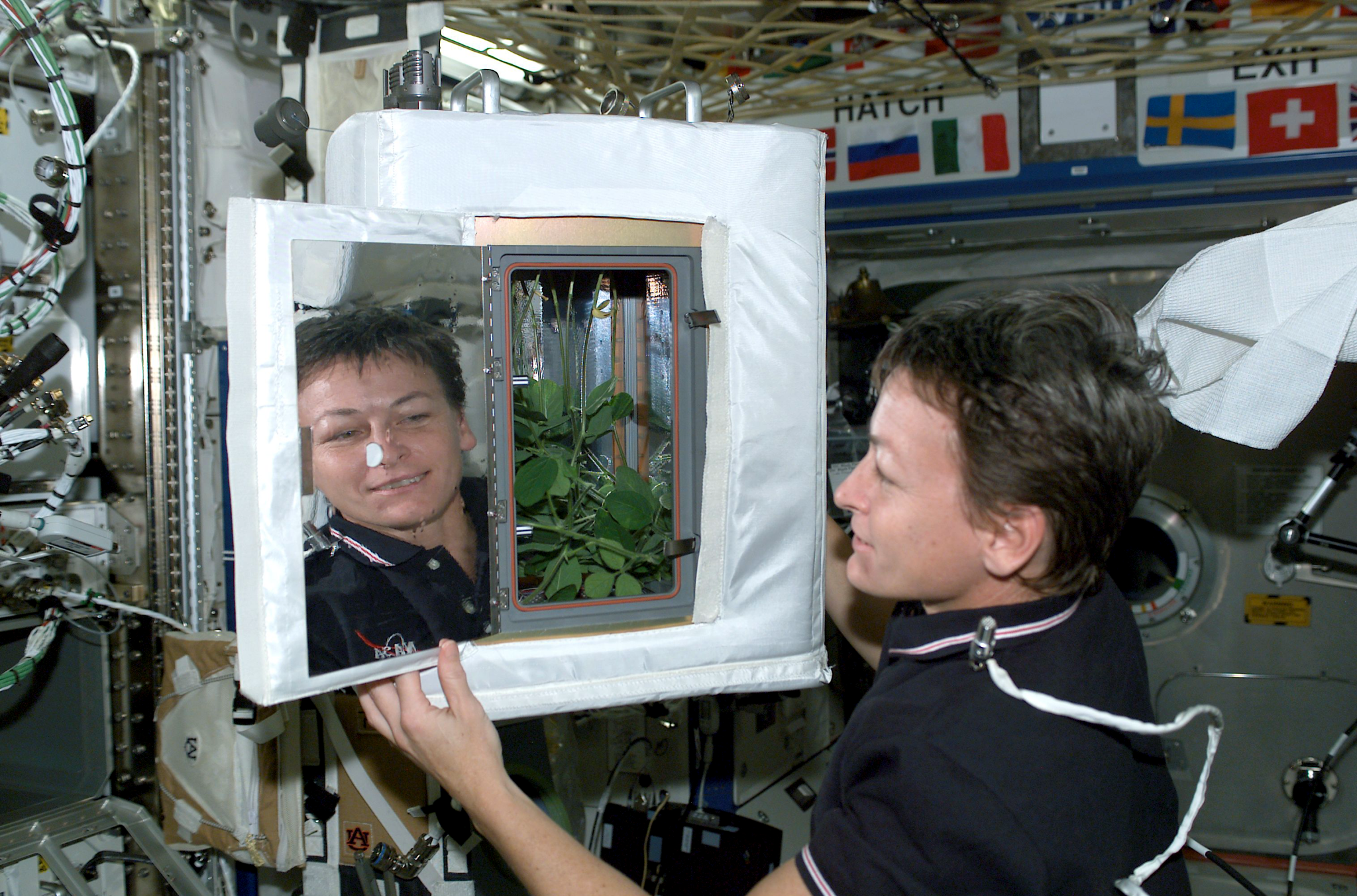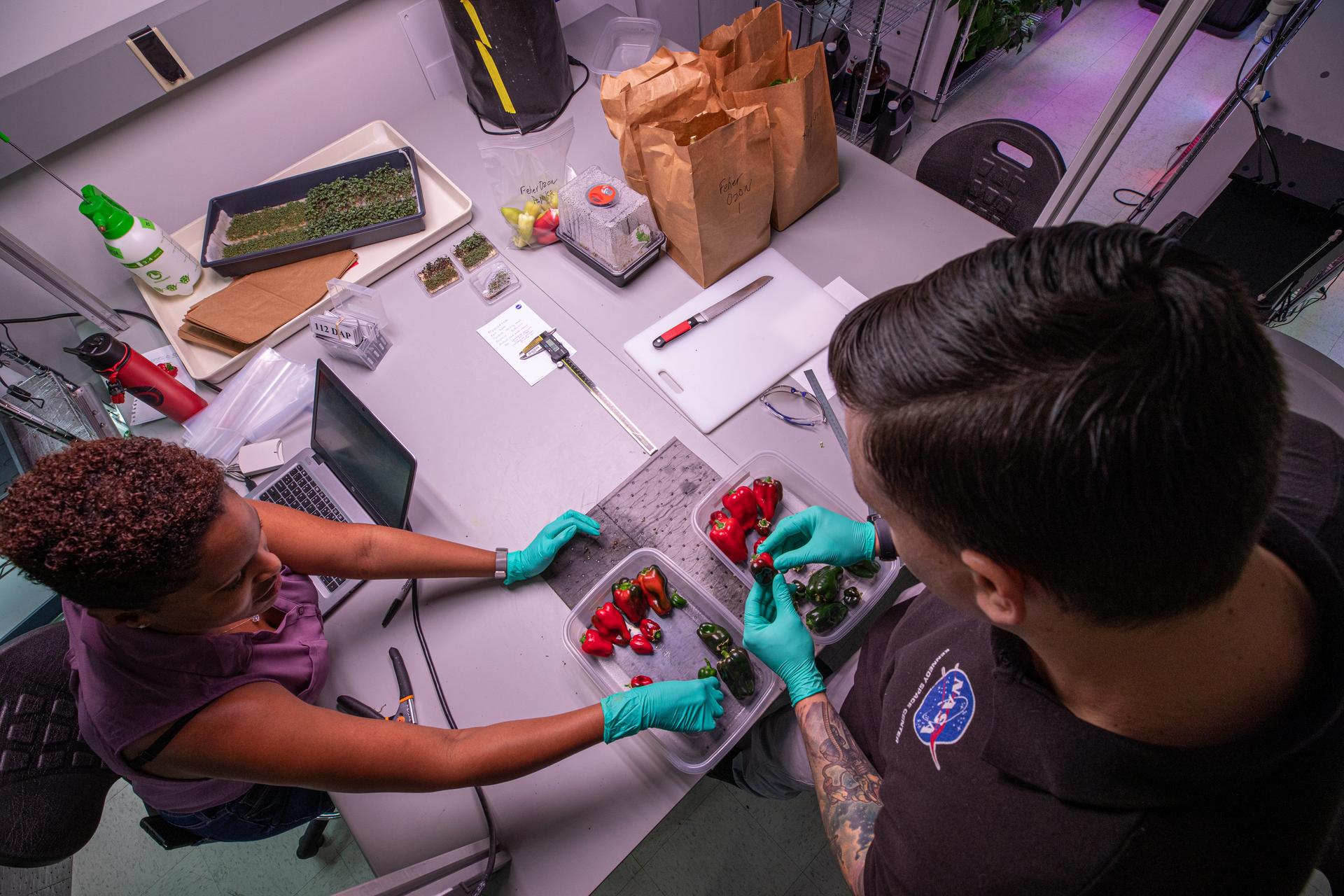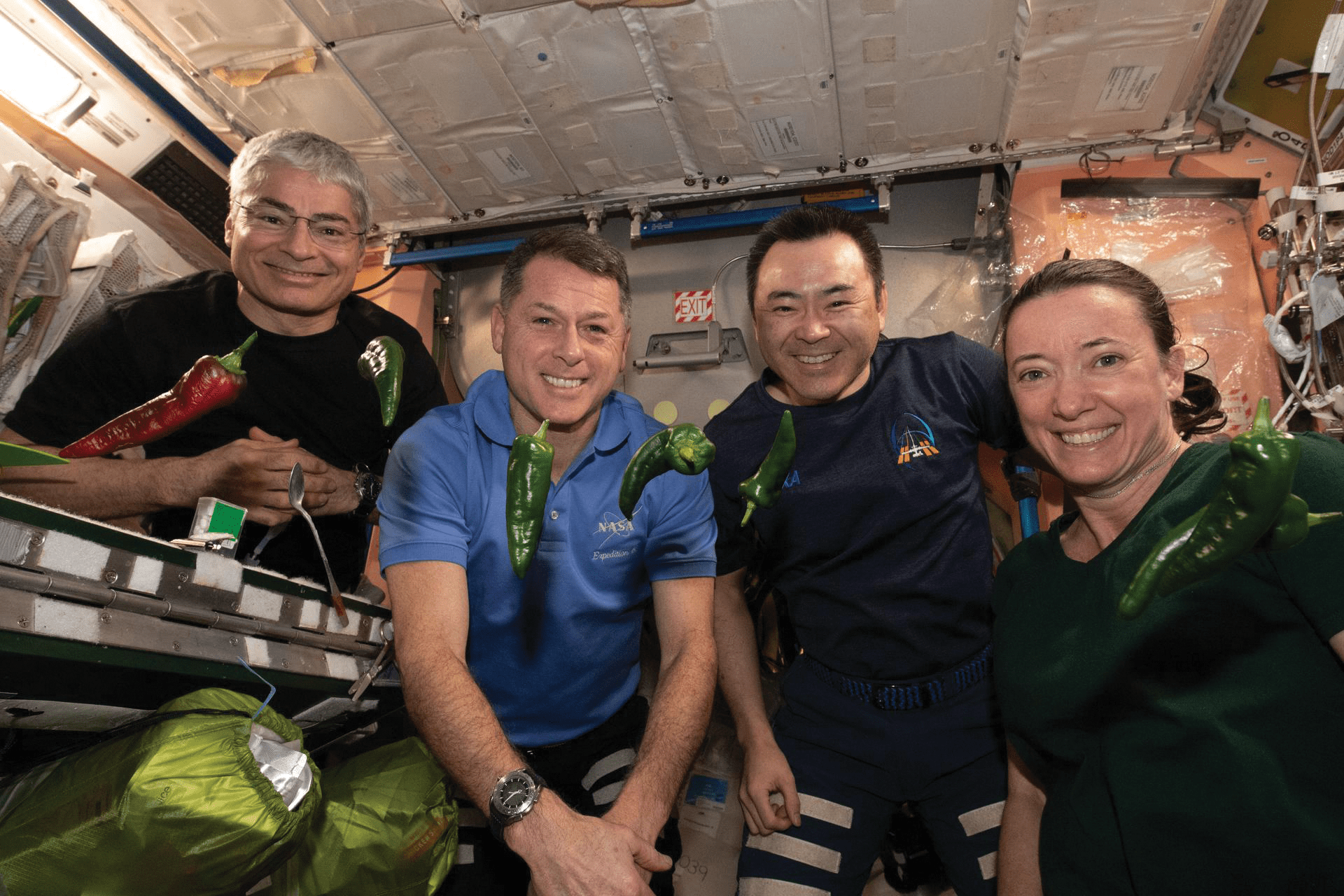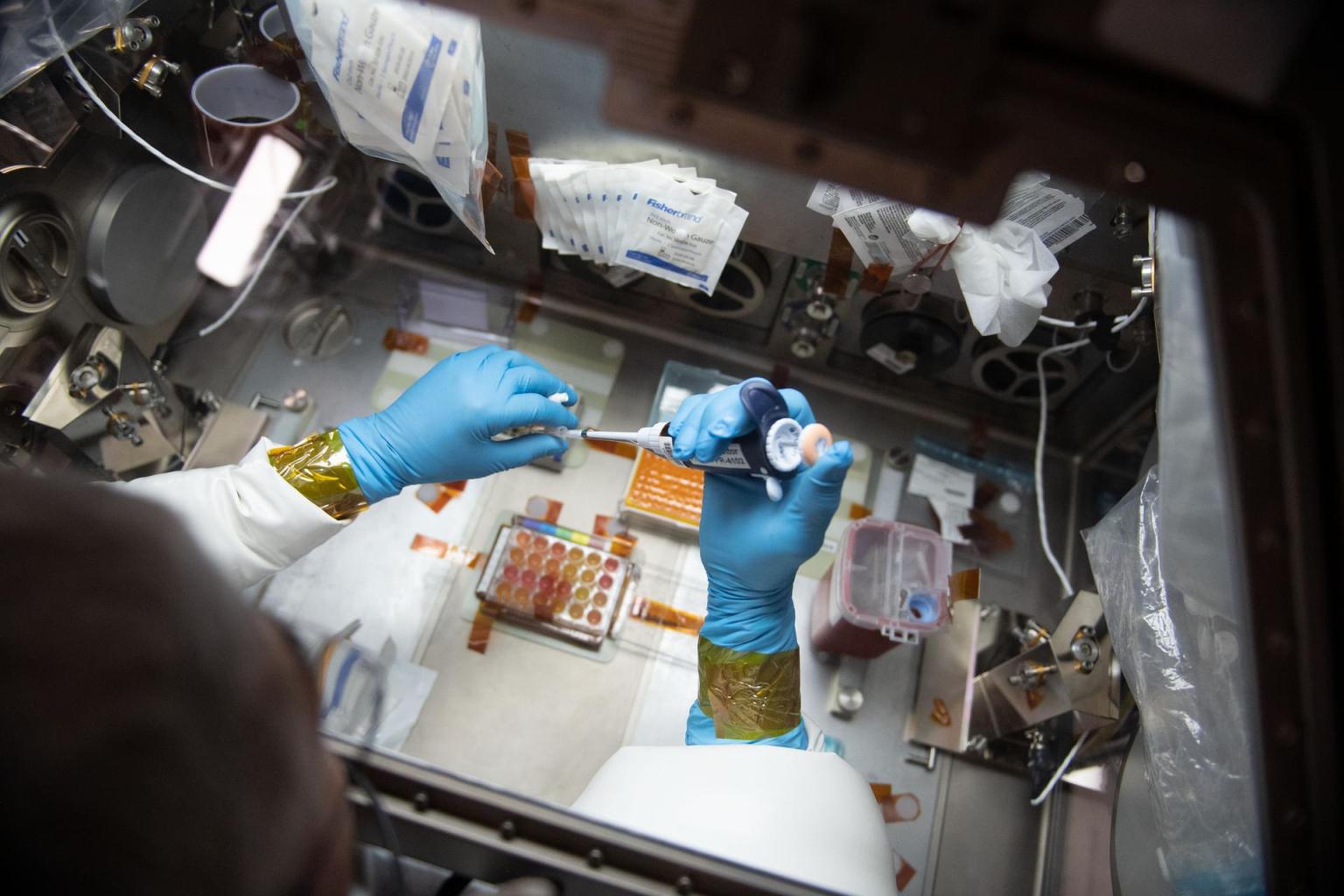Researchers are learning to grow plants in orbit to prepare us for living on other planets
While tending to a plant experiment inside the International Space Station, NASA astronaut Mike Hopkins noticed some of the plants were not doing so well. Although the mustard greens were growing fine in their special “pillows” containing clay-based growth media and fertilizer, some of the lettuces were not. “Outredgeous” Red Romaine and “Dragoon” lettuce seeds were germinating slowly, growing well behind the other plants. They would not catch up by harvest time.
With input from scientists at Kennedy Space Center in Florida, Hopkins executed the first plant transplant within NASA’s Biological and Physical Sciences (BPS)-sponsored Vegetable Production System (Veggie (PDF)). He moved extra sprouts from the thriving plant pillows into two of the struggling pillows.
On Earth, this transplant technique is risky for plants in this delicate state, and NASA had never attempted it in a space experiment. But it worked. The transplants survived and grew along with the donor kale and pak choi.
As humanity plans long-duration missions to the Moon and Mars, a key factor is figuring out how to feed crews during their weeks, months, and even years in space. What if astronauts could grow some of their own food in space?
Plants can provide crucial nutrients to supplement the prepackaged foods that can degrade in quality and nutrition after long-term storage. Researchers on Earth and crews aboard the space station are exploring the idea by testing various crops and equipment. By testing the plants in Earth orbit, we get to learn from unexpected surprises, like how to perform plant transplants, when the stakes are much lower.
“This little accidental transplant success is going to be pretty important; it opens up a lot of areas for future development,” said Matt Romeyn, a space crop production project scientist and VEG-03I science lead.
There are many challenges to growing plants in space, from watering to providing plants adequate light and room to grow. Even a simple thing such as planting a seed in space was a technical challenge that required a new application of a well-understood technology. Using strips that dissolved in water like a breath freshener strip, Hopkins was able to easily plant lettuce seeds. Researchers like Anna-Lisa Paul, horticultural sciences professor and director of the Interdisciplinary Center for Biotechnology and Research at the University of Florida, have been working to overcome the many challenges presented to plants by space since the early days of station.
“In order to run an experiment on the ground, it might take you 10 tries, half a dozen graduate students, and who knows what else to get it exactly perfect. But if you send an experiment to the space station, not only does your experiment have to work the first time, you also must make it such that an astronaut with no gravity can do the maintenance, the harvest, and the data collection,” said Paul.
Multiple space agencies have conducted station plant studies for decades. The Japan Aerospace Exploration Agency (JAXA) study, Bag Culture Experiment in the Japanese Experiment Module, helped demonstrate an engineering verification of a cultivation method using an aseptic bag culture. A series of 17 Russian space agency ROSCOSMOS (ROSCOSMOS) Rasteniya experiments studied how plants grow, develop, and reproduce in space in the Russian segment of station. NASA has successfully grown plants including lettuces and radishes and studied their response to space by analyzing everything from gene expression to spiciness. NASA’s Plant Habitat-04 experiment built on previous experiments to grow peppers in the Advanced Plant Habitat (APH). This became the longest plant experiment in space to date, growing for 137 days aboard the space station.
Seed studies have even gone outside of station as part of the Materials International Space Station Experiment (MISSE) project. The MISSE-SEED experiment exposed seeds from 11 different crops and model plants to the space environment for eight months. This was done to determine the effects from long-duration space exposure on seed quality and storage. This knowledge not only contributes to the ability for humans to one day explore Mars, but it can also have benefits to agriculture on Earth, since researchers are better able to understand specific plant responses to their environment.
Changes in gravity and the spaceflight environment can also affect how plants grow and how much produce they yield. One of the mechanisms plants use to sense gravity involves changes to calcium within their cells. JAXA recently ran experiments aboard the space station to measure how microgravity affects these calcium levels, which could offer clues for designing improved ways of growing crops for food in space. During a series of experiments using Biological Research in Canisters (BRIC), scientists performed studies on everything from plant organelles to better understand how plants sense gravity to studying genes that control responses to physical stresses like gravity.
Microgravity also presents a challenge when it comes to providing enough water to plant roots to keep them healthy without drowning them. Numerous experiments have tested a variety of methods to achieve this goal, including NASA’s Veggie studies. The Veggie facility where Hopkins performed the plant transplant is a simple, low-power gardening chamber that can hold six crop plants. Crews then look after and water the plants by hand using syringes to inject water into the plant pillows. Plants ranging from Chinese cabbage to kale to zinnias have been grown in Veggie.
The NASA Plant Water Management studies hope to push plant growth facilities to the next level. The investigation demonstrates methods to take advantage of passive measures to control fluid delivery and uptake in plant systems. These methods include using surface tension, wetting, and system geometry to replace the role of gravity as a fluid delivery mechanism.
Using the Advanced Astroculture (ADVASC) system, station crews also successfully grew two generations of Arabidopsis plants, a model organism that is well understood and often used in fundamental biology experiments. The system provided precise control of environmental parameters for plant growth, including temperature, relative humidity, light, fluid nutrient delivery, and carbon dioxide and ethylene concentrations. The experiment showed the change in gravity caused secondary branches and seed pods to grow differently.
Recognizing its potential for use in confined spaces on the ground, scientists adapted the ADVASC system for use in air purification on Earth. Initially used to prolong the shelf life of fruits and vegetables in the grocery store, the technology soon drew the attention of winemakers, who employ it in their storage cellars. According to one winemaker, the ADVASC-derived air purification system enhances storage conditions, resulting in even better wine.
“It is amazing when you think about all the innovations that are going on up in space, how they can come into a place as unexpected as a winery, which translates to benefits on your dinner table,” said Andrew Schweiger, winemaker at Schweiger Vineyards in St. Helena, California.
Multiple companies also now use this technology in air purifiers, which were shown to be effective in eliminating the SARS-CoV-2 virus. The companies have produced and distributed numerous purifiers during the pandemic.
Gardens need tending, which means growing veggies is about a lot more than the facility and plants themselves. Having humans aboard is a huge benefit to plants, especially when it comes to dealing with the unexpected. From Hopkins performing the plant transplant to NASA astronaut Megan McArthur hand pollinating chile flowers to former NASA astronaut Scott Kelly taking charge of the care of station’s zinnias when they began having difficulty growing, human tending and care has been crucial to plant success.
In addition to astronauts being a benefit to the plants, the greenery can also positively contribute to the behaviorial health and well-being of astronauts. Many crew members report they find caring for the plants a fun and relaxing activity. NASA’s space crop production group is looking to gather data on this aspect by asking astronauts who currently cultivate vegetables on the station to each complete a survey about their space gardening experiences. For example, crew members who grow mizuna mustards take the survey two to three times for the month-long growth cycle of the plant.
“Crews really seem to enjoy growing the food themselves,” said Howard Levine, chief scientist for NASA’s International Space Station Research Office at Kennedy Space Center in Florida. “It’s a nice reprieve from typical activities on the station, and astronauts often volunteer their free time to do it.”
What’s more, astronauts say the time spent gardening makes them excited to eat the fresh produce once it’s ready. The excitement motivates astronauts to use the produce creatively as ingredients in their meals, increasing their quality of life in space and boosting their morale. McArthur even created some tacos using fajita beef, rehydrated tomatoes and artichokes, and the fresh grown space station chiles. Other astronauts followed McArthur’s example, also making space tacos with chile peppers, and they expressed the same excitement at having fresh produce.
“Even though astronauts cannot run to the supermarket for fresh produce during a 2-year mission to Mars, they could float into a module that has the same smell and feel of the produce section,” Hopkins said. “And that will put a smile on any astronaut’s face.”
While humanity is just now growing small crops in space, our understanding of these organisms has increased significantly thanks to station research. This understanding of plants is a crucial tool for pushing the boundaries of space travel.
“Plants are what allow us humans to be explorers, and venture past the limits of a picnic basket, regardless of whether you are transiting an ocean or a solar system,” says Paul. “Learning about how plants respond to extreme and novel environments and how they grow under the challenges we will face when we take our biology off planet is one of the things that absolutely drives me. This is why I do this kind of work.”
Additional resources:
Project Examines How to Water Plants in Space
Veggie
Mission Commander Thrives as ‘Space Gardener’
Microgravity Works Wonders with Plant Transplants
PONDS
The Shape of Watering Plants in Space
NASA Testing Method to Grow Bigger Plants in Space
























